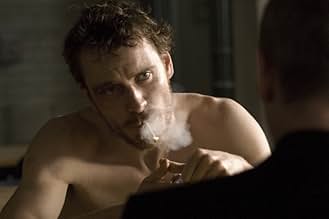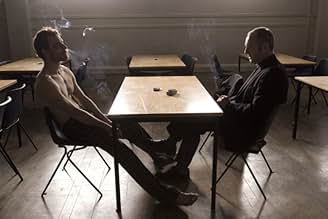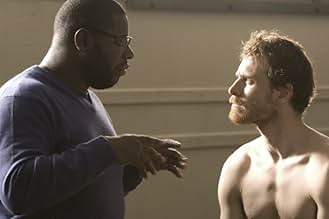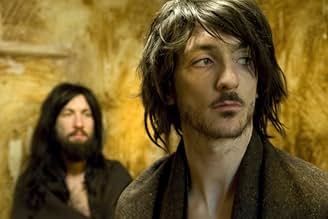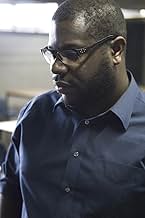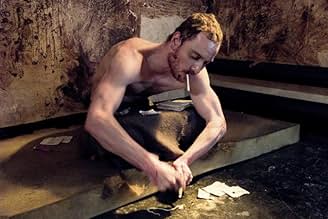Irish republican Bobby Sands leads the inmates of a Northern Irish prison in a hunger strike.Irish republican Bobby Sands leads the inmates of a Northern Irish prison in a hunger strike.Irish republican Bobby Sands leads the inmates of a Northern Irish prison in a hunger strike.
- Director
- Writers
- Stars
- Won 1 BAFTA Award
- 49 wins & 39 nominations total
- Director
- Writers
- All cast & crew
- Production, box office & more at IMDbPro
Featured reviews
Steve McQueen, a noted young British artist, has made a powerful first film about the Irish prisoners in H-Block of Maze Prison, Northern Ireland, and the hunger strike and death of Bobby Sands in 1981. The images are searing, both horrible and beautiful (McQueen is aware from Goya that images of war can be both), and much of the film is non-verbal, but the action is broken up by a centerpiece tour-de-force debate between Sands (Michael Fassbender) and Father Dominic Moran (Liam Cunningham) that is as intensely verbal as the rest is wordless. In Irish playwright Enda Walsh's rapid-fire dialogue quips are exchanged, then passionate declarations, in a duel that's like a killer tennis match: watching, we listen, and the camera, hitherto ceaselessly in motion, becomes still. Hunger, with its rich language, intense images, and devastating story, is surely one of the best English-language of the year, and it understandably won the Camera d'Or at Cannes for the best first film. Like the American Julian Schnabel, Steve McQueen is another visual artist who has turned out to be an astonishingly good filmmaker.
Faithful to the physical details of the H-blocks and the treatment of the prisoners, the film is still honed down to essentials and includes a series of sequences so intense it may take viewers a long time to digest them. As the film opens, an officer of the prison, Raymond Lohan (Stuart Graham), follows his normal routine. His knuckles are bloody and painful; later we learn why. His wife brings him sausage, rasher, and eggs.
Davey Gillen (Brian Milligan) a young Irish republican prisoner, tall, gaunt, and Christ-like, is brought into the prison. He refuses to wear the prison uniform, so, joining the Blanket protest, he's put in with fellow "non-conforming" prisoner Gerry Campbell (Liam McMahon) in a cell whose walls are smeared with feces. Those of us who were around when these events happened (Steve McQueen was 12, and remembers the coverage), remember them so well we could have seen these walls. Campbell shows Gillen hot to receive "comms" (communications) from visitors and pass them to their leader Bobby Sands at Sunday mass.
When prisoners agree to wear civilian garments, they're mocked by the "clown clothes" they're handed out and riot, screaming and yelling and tearing up everything in their cells. They also periodically collect their urine and pour it under their cell doors out into the prison hallway where the guards must walk. The result is a brutal punishment by the prison in which the prisoners are taken out to the hallway and beaten naked by a gauntlet of police in riot gear. An eventual repercussion is that Raymond Lohan is shot dead while visiting his catatonic mother in a home.
A poetic flourish of the meeting between Sands and Father Moran is Sands's story of going to the country as a Belfast boy on the cross country team and going down to a woods and a stream where he is the only one who dares to put a dying foal out of its misery by drowning it. The images this tale evoke become the objective correlative of Bobby's last thoughts when he is dying in the prison hospital.
The central issue was being treated as political prisoners. From 1972, paramilitary prisoners had held some of the rights of prisoners of war. This ended in March 1976 and the republican prisoners were sent to the new Maze Prison and its "H-blocks" near Belfast. Special Category Status for prisoners convicted of terrorist crimes was abolished by the English government. Hunger doesn't focus on ideology or public policy, other than to have the voice of Margaret Thatcher, in several orotund declarations, adamantly denying the validity of the republicans' cause or status. The Sands-Moran debate is more about feelings and tactics.
Another powerful contrast comes when Sand goes on the hunger strike and is taken to the clean, quiet setting of the hospital where he is lovingly cared for and visited by a good friend and his parents, who're even allowed to sleep there during his last days. Sands' condition is dramatic, heightened by horrible sores, and a report to his parents of the rapid damage to internal organs and heart that his fast will cause.
It was McQueen's decision to eschew a screenwriter in favor of a playwright for the script, and his choice of his near-contemporary Enda Walsh, an Irishman resident in London, was a wise one. McQueen determined the structure and inspired the paring down. Walsh makes the central verbal scene sing. Its intensity is such that it has no trouble at all competing with the harsh prison scenes. It is brilliant stroke. Great theater you could say, but the film's contribution is to make the whole train of events alive and human at a time when they are acutely relevant to the post 9/11 world of Guantanamo and Abu Ghraib.
Shown at Cannes, Telluride, and Toronto, included in the New York Film Festival 2008.
Faithful to the physical details of the H-blocks and the treatment of the prisoners, the film is still honed down to essentials and includes a series of sequences so intense it may take viewers a long time to digest them. As the film opens, an officer of the prison, Raymond Lohan (Stuart Graham), follows his normal routine. His knuckles are bloody and painful; later we learn why. His wife brings him sausage, rasher, and eggs.
Davey Gillen (Brian Milligan) a young Irish republican prisoner, tall, gaunt, and Christ-like, is brought into the prison. He refuses to wear the prison uniform, so, joining the Blanket protest, he's put in with fellow "non-conforming" prisoner Gerry Campbell (Liam McMahon) in a cell whose walls are smeared with feces. Those of us who were around when these events happened (Steve McQueen was 12, and remembers the coverage), remember them so well we could have seen these walls. Campbell shows Gillen hot to receive "comms" (communications) from visitors and pass them to their leader Bobby Sands at Sunday mass.
When prisoners agree to wear civilian garments, they're mocked by the "clown clothes" they're handed out and riot, screaming and yelling and tearing up everything in their cells. They also periodically collect their urine and pour it under their cell doors out into the prison hallway where the guards must walk. The result is a brutal punishment by the prison in which the prisoners are taken out to the hallway and beaten naked by a gauntlet of police in riot gear. An eventual repercussion is that Raymond Lohan is shot dead while visiting his catatonic mother in a home.
A poetic flourish of the meeting between Sands and Father Moran is Sands's story of going to the country as a Belfast boy on the cross country team and going down to a woods and a stream where he is the only one who dares to put a dying foal out of its misery by drowning it. The images this tale evoke become the objective correlative of Bobby's last thoughts when he is dying in the prison hospital.
The central issue was being treated as political prisoners. From 1972, paramilitary prisoners had held some of the rights of prisoners of war. This ended in March 1976 and the republican prisoners were sent to the new Maze Prison and its "H-blocks" near Belfast. Special Category Status for prisoners convicted of terrorist crimes was abolished by the English government. Hunger doesn't focus on ideology or public policy, other than to have the voice of Margaret Thatcher, in several orotund declarations, adamantly denying the validity of the republicans' cause or status. The Sands-Moran debate is more about feelings and tactics.
Another powerful contrast comes when Sand goes on the hunger strike and is taken to the clean, quiet setting of the hospital where he is lovingly cared for and visited by a good friend and his parents, who're even allowed to sleep there during his last days. Sands' condition is dramatic, heightened by horrible sores, and a report to his parents of the rapid damage to internal organs and heart that his fast will cause.
It was McQueen's decision to eschew a screenwriter in favor of a playwright for the script, and his choice of his near-contemporary Enda Walsh, an Irishman resident in London, was a wise one. McQueen determined the structure and inspired the paring down. Walsh makes the central verbal scene sing. Its intensity is such that it has no trouble at all competing with the harsh prison scenes. It is brilliant stroke. Great theater you could say, but the film's contribution is to make the whole train of events alive and human at a time when they are acutely relevant to the post 9/11 world of Guantanamo and Abu Ghraib.
Shown at Cannes, Telluride, and Toronto, included in the New York Film Festival 2008.
It's 1981. Raymond Lohan (Stuart Graham) is a guard in the Maze Prison, Northern Ireland. Davey Gillen is a new IRA prisoner who refuses to wear prison uniforms. He's put in with Gerry who has smeared the cell with his own feces. They smuggle things in and out of the prison. Bobby Sands (Michael Fassbender) leads the prisoners in a hunger strike.
It's quiet film and full of little details. It doesn't wallow in the brutality but lets it envelop the movie. There is a realism in the movie that is more powerful than any flash or action sequence. One really gets the sense of dehumanization. Dialog is sparse but there is a great discussion between Sands and Father Dominic Moran. This is quietly brutal and some great performances including Fassbender.
It's quiet film and full of little details. It doesn't wallow in the brutality but lets it envelop the movie. There is a realism in the movie that is more powerful than any flash or action sequence. One really gets the sense of dehumanization. Dialog is sparse but there is a great discussion between Sands and Father Dominic Moran. This is quietly brutal and some great performances including Fassbender.
Hunger is a low budget film from a production company more recognisable for its TV work, without any recognisable stars, without a really big distributer to get it around and directed by a Turner Prize winning visual artist making his film debut. Already you would perhaps be considering giving it a miss and maybe this isn't the best time to mention it is a largely dialogue free account of hunger-striker Bobby Sands set entirely in Northern Ireland's infamous Maze prison. This is probably one of the reasons that the film hasn't been as widely seen as it deserves to be or why audiences haven't flocked into screenings of it on a Saturday night. Certainly it is not an easy watch given the subject matter alone but yet it is a compelling and quite brilliant film.
Although the nature of the story leads the viewer to be emotionally invested in one "side" of the situation, McQueen never does anything that opens his film to this suggestion of bias or of scoring political points, if anything his attention to the detail of the tightly focused story does just the opposite. As well as telling us how many hunger strikers died, he point out how many prison guards were murdered during the period and, in my favourite part, introduces us to the prison via one guard soothing his hands (which tells us the frequency of what he does). It is a nice moment but not as telling as the thrill the viewer gets as he checks for bombs and starts his car we are supposed to be on the edge of our seat and we are, swiftly followed by the realisation that this is an experience we would repeat if we were in his driveway the next day or the next.
From here we move into a nearly dialogue free thirty minute opening where no central character really comes forward and our "focus" is on life in the prison for guards and prisoners a story that almost starts without there being a "story". The film later brings Bobby Sands to the fore, delivering one impressive dialogue scene before returning to a dialogue-light charting of his hunger strike on the way to the conclusion that we all know is coming. Yet it manages to be really engaging because of the level of each detail in each scene and the relevance of each scene to the overall film. The scene that has gotten all the mentions and praise is the long dialogue scene between Sands and the priest who comes to see him before his strike. Filmed in three distinct shots, the scene is technically impressive but also allows the main dialogue delivery of the film and the only really moment where anyone is allowed to debate and discuss the actions. Even here McQueen does not allow sides to be taken but keeps it as two men talking. It is engaging, really well written and of course, really well acted.
It is ironic that in this scene the film sits still for ages and allows the frame to remain the same because for the majority of the film McQueen's camera is the star. So many shots are striking that it almost becomes "normal" to be transfixed by an image on the screen. Whether it be a excrement-smeared cell, urine flowing down a hall or a man washing blood from his hands, it looks great and the care taken to construct each image fills the "gap" that the dialogue leaves. The performances are mostly very good and compliment the "few words" approach by bringing a lot when required and wearing their characters convincingly. There are some you may recognise but I didn't. Fassbender is the most memorable as he has the biggest character and the most startling journey, but this should not take away from smaller turns from Graham, Mullen and a few others who are also good. The film is not perfect though. The uninitiated may struggle to understand the bigger picture as you don't get a lot of help with that and those that don't get into the telling initially may be left cold by the approach. However these "weaknesses" are not missed targets or failings but rather the "cons" that have to come with the overwhelming pros of the manner of delivery.
Hunger is not an easy film to watch but it is a great film. It is wonderfully shot with an artist's composure but McQueen is not a "visual style" director who doesn't come with anything else (list your own failed music video director turned film director here) but rather he uses this approach to improve the film and make the telling better. The acting is impressive because of how real they feel and how little dialogue they have across the whole film, but to me the real star was McQueen. He is a visual artist and it shows as he makes the majority of his shots striking and engaging, even if they are not "beautiful". It may get a bit more exposure due to awards chatter but even if it doesn't it is certainly worth checking out.
Although the nature of the story leads the viewer to be emotionally invested in one "side" of the situation, McQueen never does anything that opens his film to this suggestion of bias or of scoring political points, if anything his attention to the detail of the tightly focused story does just the opposite. As well as telling us how many hunger strikers died, he point out how many prison guards were murdered during the period and, in my favourite part, introduces us to the prison via one guard soothing his hands (which tells us the frequency of what he does). It is a nice moment but not as telling as the thrill the viewer gets as he checks for bombs and starts his car we are supposed to be on the edge of our seat and we are, swiftly followed by the realisation that this is an experience we would repeat if we were in his driveway the next day or the next.
From here we move into a nearly dialogue free thirty minute opening where no central character really comes forward and our "focus" is on life in the prison for guards and prisoners a story that almost starts without there being a "story". The film later brings Bobby Sands to the fore, delivering one impressive dialogue scene before returning to a dialogue-light charting of his hunger strike on the way to the conclusion that we all know is coming. Yet it manages to be really engaging because of the level of each detail in each scene and the relevance of each scene to the overall film. The scene that has gotten all the mentions and praise is the long dialogue scene between Sands and the priest who comes to see him before his strike. Filmed in three distinct shots, the scene is technically impressive but also allows the main dialogue delivery of the film and the only really moment where anyone is allowed to debate and discuss the actions. Even here McQueen does not allow sides to be taken but keeps it as two men talking. It is engaging, really well written and of course, really well acted.
It is ironic that in this scene the film sits still for ages and allows the frame to remain the same because for the majority of the film McQueen's camera is the star. So many shots are striking that it almost becomes "normal" to be transfixed by an image on the screen. Whether it be a excrement-smeared cell, urine flowing down a hall or a man washing blood from his hands, it looks great and the care taken to construct each image fills the "gap" that the dialogue leaves. The performances are mostly very good and compliment the "few words" approach by bringing a lot when required and wearing their characters convincingly. There are some you may recognise but I didn't. Fassbender is the most memorable as he has the biggest character and the most startling journey, but this should not take away from smaller turns from Graham, Mullen and a few others who are also good. The film is not perfect though. The uninitiated may struggle to understand the bigger picture as you don't get a lot of help with that and those that don't get into the telling initially may be left cold by the approach. However these "weaknesses" are not missed targets or failings but rather the "cons" that have to come with the overwhelming pros of the manner of delivery.
Hunger is not an easy film to watch but it is a great film. It is wonderfully shot with an artist's composure but McQueen is not a "visual style" director who doesn't come with anything else (list your own failed music video director turned film director here) but rather he uses this approach to improve the film and make the telling better. The acting is impressive because of how real they feel and how little dialogue they have across the whole film, but to me the real star was McQueen. He is a visual artist and it shows as he makes the majority of his shots striking and engaging, even if they are not "beautiful". It may get a bit more exposure due to awards chatter but even if it doesn't it is certainly worth checking out.
This debut from former artist turned director Steve McQueen will leave you breathless. In its own understated way it is epic, bold, brutal and beautiful. Telling the story of the last six weeks in the life of Bobby Sands the Irish republican hunger striker the film pulls no punches in showing life inside the maze prison and what the prisoners did to try and win political status. From the outset the shots are amazing with McQueen utilising his artistic eye to bring the best out of the very cold prison environment, his attention to detail is simply stunning making every single frame fantastically watchable despite the sometimes gruesome subject matter. Also his approach of less is more adds to the atmosphere as he has shots that have no sounds or music, like the guard cleaning the corridor with its fixed camera unflinching for several minutes the only sound the eerie echoing scrubbing. Unofficially split into three the first part deals with the incarceration and subsequent no wash protests while the last deals with the hunger strikes but it's the central piece that separates which most will remember for its ability to captivate despite just being a conversation between Sands and a visiting priest. Again shot from a fixed angle and superbly lit Sands (Fassbender) explains the morality behind his decision to stop eating. The acting and the monologue will stay with you long after the films finished and cements actor Fassbender firmly in the role to the point where you start to feel for him as he begins to waste away. When the film premiered at Cannes it caused walkouts and standing ovations before walking away with the Camera d'Or for best debut and rightly so, not only is it one of the best films of the year it is one of the most powerful I've seen. Regardless of where you stand politically the message is universal and just like the circle of faeces smeared on Sands cell wall, McQueen has crafted something beautiful out of something horrible.
Bobby Sands (Michael Fassbender) did something that was a risk, one that would have made others squirm or back out. He was in prison already for four or more years, as a leader in the IRA in Ireland, when he decided to go on a hunger strike. Not just him, mind you, but others along with him, who would all go hungry and, more than possibly, put their bodies on the line for the sake of their brothers in the war, until Britain did something. But the brilliance of Hunger is that director Steve McQueen (not to be confused with the action star) gives us a very straightforward (shockingly so) view of the conditions at the prison, the cell-block where IRA members were put in cells, inhumanely in fact, with feces commonly strewn on the walls and prisoners regularly beaten by SWAT teams and prison guards in general... then, after a very long scene of talk where Sands hears his own plan in front of a priest, the hunger strike in action. It's unrelenting cinema.
It's also sometimes a bit much to take in. You have to know this is not at all melodramatic, but done with little dialog, sometimes in just a few words or whispers (a female narrator pops up once or twice to put things into a sort of context), and compositions that bring out claustrophobia and the endless time spent in the prison. One might wonder why McQueen chooses to keep a shot going for so long on something as trivial, or just routine, as a guard cleaning up the urine left by all the prisoners in the hallways (all in one shot), but it's about that really: the routine of a horrible process of living, of 'us' and 'them' between the prisoners and the guards in this Northern Ireland prison, with Sands as a sort of unofficial leader inside. The length of shots, and the moments where characters burst out in anger and rage, are deliberate and dramatic and powerful.
If I had any problem with Hunger, it's that it is misleading in its first half hour. We're given two prisoners, not Sands, and a prison guard, and we're shown the horrid conditions of living in a solitary-confined prison (feces on the wall, anyone?). But Bobby Sands, the main character, isn't introduced for quite a while. It's an outstanding scene when he is introduced, kicking and pounding and getting beaten down as his hair and beard are cut, yet by then it's been perhaps too long to get to this point. It's also jarring how McQueen structures his film it terms of silent and sound: there's a fifteen minute stretch (almost all in one two-shot) where there's nothing but dialog between Sands and the priest (albeit a riveting conversation about sacrifice and humanity), but aside from this it's all just watching first the IRA members in the horror of prison conditions, and second Sands in his deterioration of the hunger strike.
And yet it is a powerful experience and a stunning debut. It reminds me a little like The Machinist in observing its lead character fade away, literally, before our eyes, only here the stakes are far greater than a tricky neo-noir plot. Fassbender is also mesmerizing for any given moment he's on screen. And yet as great as the film ultimately may be, or is, I don't have a desire to watch it again. It's about as bleak as a rainy day in Dublin - I mean a real rainy day. You won't feel good when the movie ends, but you'll know you have seen the emergence of a filmmaker with something to say, and an actor who will go to the limits, much like Christian Bale, for the sake of the character's importance in the story. Frankly, it rarely gets more dramatic and life-or-death than Bobby Sands.
It's also sometimes a bit much to take in. You have to know this is not at all melodramatic, but done with little dialog, sometimes in just a few words or whispers (a female narrator pops up once or twice to put things into a sort of context), and compositions that bring out claustrophobia and the endless time spent in the prison. One might wonder why McQueen chooses to keep a shot going for so long on something as trivial, or just routine, as a guard cleaning up the urine left by all the prisoners in the hallways (all in one shot), but it's about that really: the routine of a horrible process of living, of 'us' and 'them' between the prisoners and the guards in this Northern Ireland prison, with Sands as a sort of unofficial leader inside. The length of shots, and the moments where characters burst out in anger and rage, are deliberate and dramatic and powerful.
If I had any problem with Hunger, it's that it is misleading in its first half hour. We're given two prisoners, not Sands, and a prison guard, and we're shown the horrid conditions of living in a solitary-confined prison (feces on the wall, anyone?). But Bobby Sands, the main character, isn't introduced for quite a while. It's an outstanding scene when he is introduced, kicking and pounding and getting beaten down as his hair and beard are cut, yet by then it's been perhaps too long to get to this point. It's also jarring how McQueen structures his film it terms of silent and sound: there's a fifteen minute stretch (almost all in one two-shot) where there's nothing but dialog between Sands and the priest (albeit a riveting conversation about sacrifice and humanity), but aside from this it's all just watching first the IRA members in the horror of prison conditions, and second Sands in his deterioration of the hunger strike.
And yet it is a powerful experience and a stunning debut. It reminds me a little like The Machinist in observing its lead character fade away, literally, before our eyes, only here the stakes are far greater than a tricky neo-noir plot. Fassbender is also mesmerizing for any given moment he's on screen. And yet as great as the film ultimately may be, or is, I don't have a desire to watch it again. It's about as bleak as a rainy day in Dublin - I mean a real rainy day. You won't feel good when the movie ends, but you'll know you have seen the emergence of a filmmaker with something to say, and an actor who will go to the limits, much like Christian Bale, for the sake of the character's importance in the story. Frankly, it rarely gets more dramatic and life-or-death than Bobby Sands.
Did you know
- TriviaHunger is known for its unbroken 17 minute 10 second continuous shot, in which Catholic priest Father Dominic Moran tries to talk Bobby Sands out of the Hunger Strike he and his fellow 75 IRA members plan to start. The camera remains in the same position throughout the scene. To prepare, Liam Cunningham moved into Michael Fassbender's apartment, and they rehearsed the scene 12-15 times per day. On the first day of filming, the actors got it perfect after 4 takes.
- GoofsThatcher's speech that says "the men of violence have chosen in recent months to play what may well be their last card" is shown in the film when the hunger strike is beginning, but it was actually made after Bobby Sands had died. It was made on 28th May 1981. Bobby Sands died on 5th May 1981.
- Quotes
Bobby Sands: I have my belief, and in all its simplicity that is the most powerful thing.
- ConnectionsFeatured in Front Row: Michael Fassbender/Kate Winslet (2017)
- SoundtracksIndustry
Performed by Maya Beiser
Composed by Michael Gordon
Published by Red Poppy in association with G. Schirmir, Inc.
Details
- Release date
- Countries of origin
- Official site
- Languages
- Also known as
- Tù Khổ Sai
- Filming locations
- Production companies
- See more company credits at IMDbPro
Box office
- Budget
- £1,500,000 (estimated)
- Gross US & Canada
- $154,084
- Opening weekend US & Canada
- $1,980
- Dec 7, 2008
- Gross worldwide
- $3,185,113
- Runtime1 hour 36 minutes
- Color
- Sound mix
- Aspect ratio
- 2.35 : 1
Contribute to this page
Suggest an edit or add missing content




